ARCHIVE · 2014
PERO ŠANTIĆ
A METICULOUS CHRONICLE OF SILENCE
Curator: mr.sc. Vesna Delić Gozze, prof.
December 20th 2014 – March 1st 2015
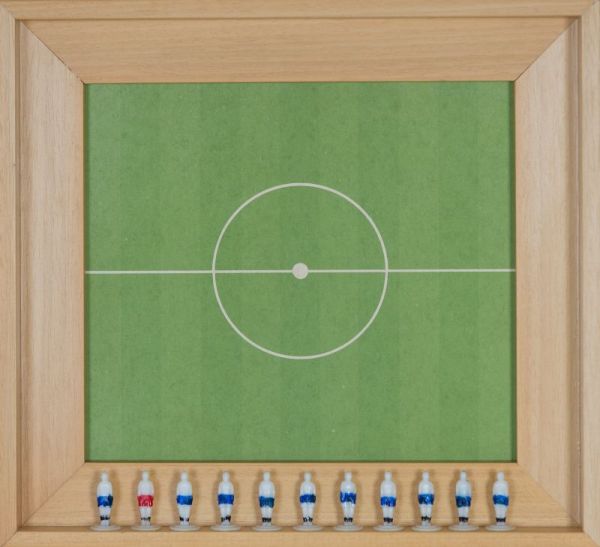
Svjetsko prvenstvo u nogometu, 2014.
The retrospective exhibition A Meticulous Chronicle of Silence of Dubrovnik's painter Pero Šantić has been open in Gallery Dulčić Masle Pulitika and Studio Pulitika at 20th December 2014.
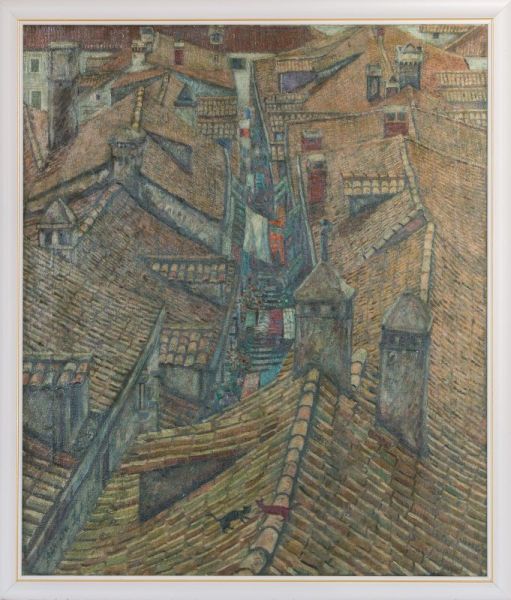
Jugo,1984.
"While the realist approached to detail in a good part of the oeuvre of Šantić’s paintings has no connection with the realism of the whole but brings him close to the naturalism of surrealism, in his drawings, the calligraphy of the stone surface and the primacy of the rural motifs of rough dressed stone via the precision of pen drawing is transferred into a faithful impression of the whole impression of the seen (Pomegranate). The stone landscape, the hamlets, the stone boundary lines are not in Šantić just fences and dividing marks, they are sculptural units with their own stony plants (Stone Gate)."
Vesna Delić Gozze
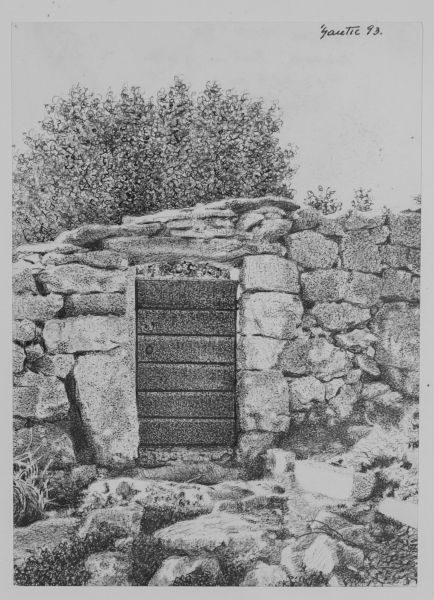
Seoski motiv, 1993.
Šantić is simply a unique poetic realist who during his endlessly long walks around the paths and landscapes of Konavle and Dubrovačko primorje has discovered the beauty of the sturdy dry stone boundary walls that like a stalwart guard protect the plants growing on the modest little clumps of nurturing earth. He respects and marvels at this beauty, conveying it with fascinating skill and the meticulous care of the medieval miniaturist.
Sonja Seferović
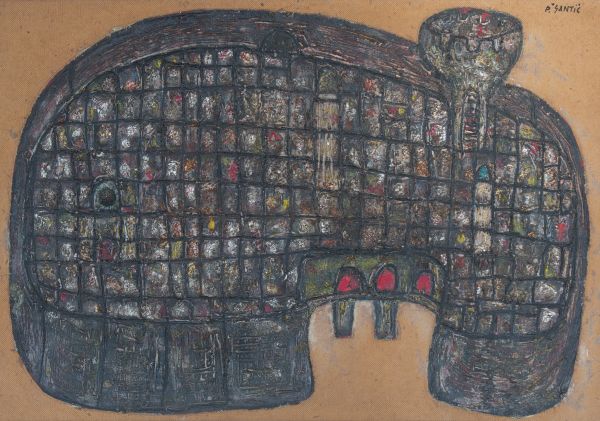
Dubrovnik, 1998.
BIOGRAFIJA
Pero Šantić rođen je u vojvođanskom Velikom Bečkereku, današnjem Zrenjaninu, u Srbiji, 7. travnja 1938. Osnovnu školu i četiri godine srednje škole, završio u Dubrovniku. Školu za primjenjene umjetnosti u Herceg Novom, Crna Gora, upisuje 1954. u trajanju od pet godina, do 1959. Studirao na Akademiji za primjenjene umjetnosti u Beogradu od 1962. i napušta je, nezadovoljan, 1965. Član ULUH-a (današnji HDLU) Dubrovnik je od 1970. Opredjeljuje se za status slobodnog umjetnika. Živi u Dubrovniku i Austriji.
MIROSLAV KRALJEVIĆ
1885 – 1913
Retrospective

SELF-PORTRAIT WITH DOG, 1910, oil/canvas; 111.7 x 85.7 cm (Photo by: Goran Vranić)
AUTHORS:
Zvonko Maković
Željko Marciuš
Biserka Rauter Plančić
December 11th, 2014 – February 8th 2015
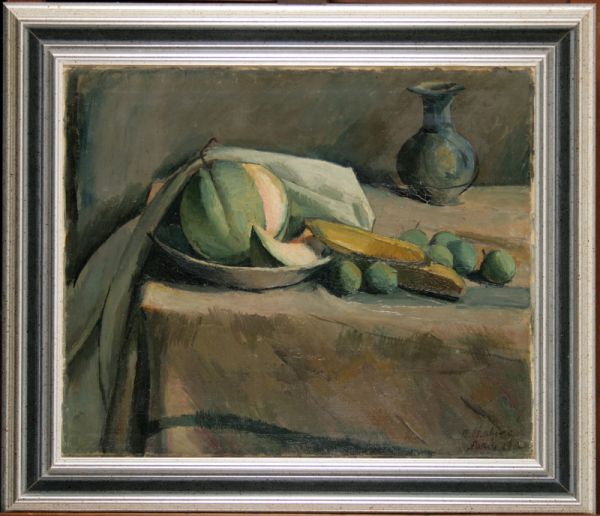 Mrtva priroda s dinjom, 1912.
Mrtva priroda s dinjom, 1912.
"The extremely abundant and varied opus by Miroslav Kraljević, concentrated in a mere five years of intense creativity (1908-1913), was a starting point for a series of the great figures of 20th century Croatian painting (Milivoj Uzelac, Marijan Trepše, Vilko Gecan, and Milan Steiner), who defined what he had not managed to achieve because of his premature death. In other words, even as adolescents, they recognized the spirit of a new age, represented by the expressionism that Kraljević intuitively discovered in some of his late works, and they introduced this option into Croatian painting, at first sporadically during World War I, and in its fullest sense in the years immediately after it. Kraljević's greatest contribution to Croatian painting lies in the fact that his work articulated an entire generation, which fully developed those theses which he, due to his short life and effective creation, managed only to outline. No other role model was as important as Miroslav Kraljević to the generation that matured during the World War I and confirmed their expression during the exhibitions of the Zagreb Spring Salon. If we take into consideration that the most valuable part of Kraljević’s art is concentrated in a single year – the last year of his life (1912-1913) – then the power of this art, indeed, has a special meaning."
Zvonko Maković
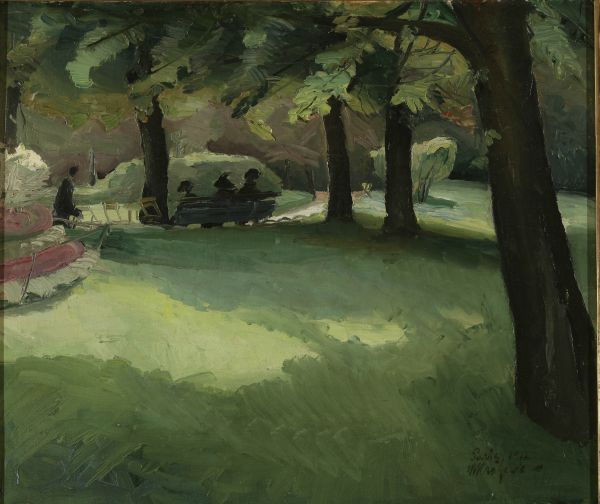 PARC DU LUXEMBOURG, 1911/1912, oil/canvas; 49 x 61 cm, (Photo by: Goran Vranić)
PARC DU LUXEMBOURG, 1911/1912, oil/canvas; 49 x 61 cm, (Photo by: Goran Vranić)
BIOGRAPHY:
1885
Miroslav Kraljević was born into a well-regarded aristocratic family while his father was serving in an administrative post in Gospić.
1888-1903
Miroslav Kraljević completed elementary and high school in Zagreb and Gospić; but he also spent one high-school year in Požega, the home of his father’s family, which he considered his home town.
1904-1905
Miroslav studied law in Vienna and attended a painting course run by George Fischoff.
1906
He abandoned his study of the law and totally dedicated himself to art.
He enrolled in the printmaking school of Mortiz Heymann in Munich.
1907-1909
Miroslav Kraljević enrolled in the Academy of Fine Arts in Munich, class of Hugo von Habermann.
At that time, other Croatian painters were studying in Munich: Josip Račić, Vladimir Becić and Oskar Herman.
His friends at that time were Vladimir Becić, Oskar Herman, Nasta Rojc, Erna Šaj, the Polish - Romanian painter Karl Ewald Olszewski.
1910-1911
After the end of his education in the Academy of Fine Arts in Munich, he returned to Požega, from which, after a short time, he went to Kraljevica, a town on the sea, in the vain hope of being cured of his advanced consumption.
Back to Požega again, he was met by a number of commissions for portraits; his return to his home ground also resulted in a number of outstanding portraits of his family, landscapes, still lifes and animal paintings.
1911
Kraljević exhibited at the exhibition of the Croatian Society of Art in Zagreb, where his outstanding qualities as a painter were observed and highlighted by Izidor Kršnjavi, head of the Religion and Teaching Department, and by poet and essayist Antun Gustav Matoš, without doubt the greatest authority Croatian reviewing and criticism had ever had.
As a result of these successes, he was awarded a scholarship and left for Paris, where he worked at the academy of La Grande Chaumière and painted some of his best portraits, self-portraits, genre scenes and views.
1912
This was a year of euphoric painting and drawing, with a superlative elaboration of previous experience and bold investigations of new ideas and idioms.
At the same time that his talent was burgeoning in Paris, Kraljević increasingly thought of going back home.
His first one-man show in the Ullrich Salon in Zagreb was attended by excellent reviews.
1913
In Zagreb, Miroslav Kraljević died of consumption at the age of 27.
1942
Five Kraljević oil paintings were included in the 23rd Exhibition of the Venice Biennale.
2013
The exhibition Miroslav Kraljević – A Retrospective Exhibition was opened in the Modern Gallery in Zagreb marking the centenary of the artist’s death, constituting the biggest exhibition to date of this Croatian painter of the soul.
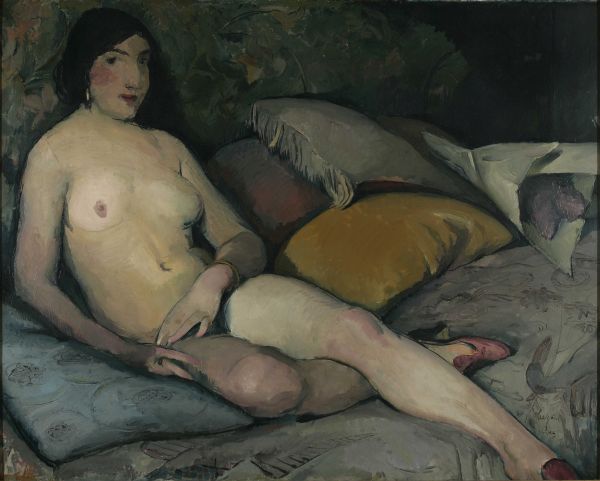 OLYMPIA (LARGE NUDE), 1912, oil/canvas; 89 x 112 cm, (Photo by: Goran Vranić)
OLYMPIA (LARGE NUDE), 1912, oil/canvas; 89 x 112 cm, (Photo by: Goran Vranić)
MARKO MURAT
An exhibition to mark the 150th anniversary of the artist’s birth and the 70th anniversary of his death
Author: Ivan Viđen
Coordinator: Rozana Vojvoda
November 21st – December 14th 2014.
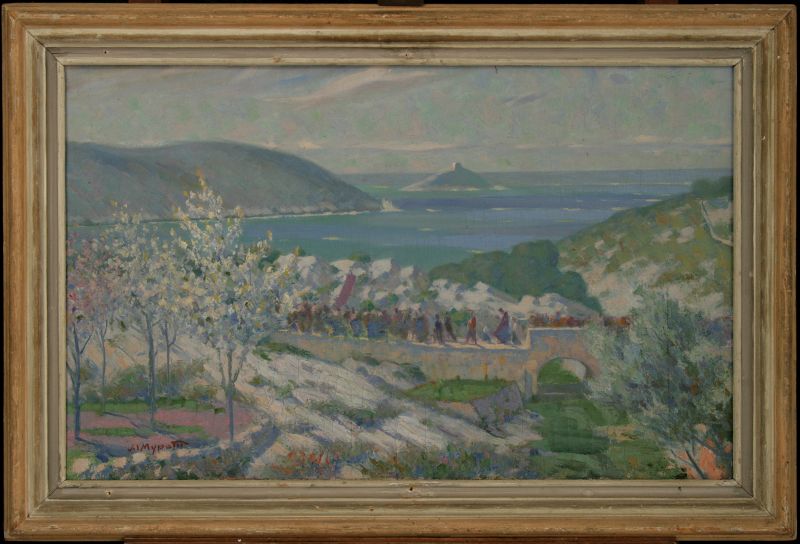
Procession in the Village of Orašac (c. 1908)
About Murat, among other things, the author of the exhibition in the catalogue has wrote: „With respect to Murat’s style, it has to be said that he evolved from Academicism and the pure plein air style and moved in the direction of a kind of ideal naturalism. This process sprang from his success with Flowers in Dubrovnik at the Munich exhibition in 1893, the World Exhibition in Paris in 1900 and his stay in Rome in 1901 when the works Arrival of Emperor Dušan in Dubrovnik, Daphnis and Chloe and A Breath of Dubrovnik Spring were created, changed with the gradual move away from Lada and becoming closer with Meštrović (1883-1962) and the Medulić Art Association and in his later years “in the wonderful isolation of Dubrovnik” ended in an entirely different line. Murat was in the course of time increasingly occupied by folk poetry, myth, legend and history more than by nature, and so the expected results of the different ideational and formal approach had to be fulfilled in paintings like Nostalgia, St Blaise Watching over Dubrovnik, the Finding of the Head of Prince Lazar, large format compositions that were entirely suffused with the spirit of symbolism. In order to achieve as ideal a form as he could, Murat sometimes emphasised the literary narrative as against the pictorial qualities, and sometimes created a painting not burdened by its subject, rather according to his internal dictate and according to autonomous laws.“
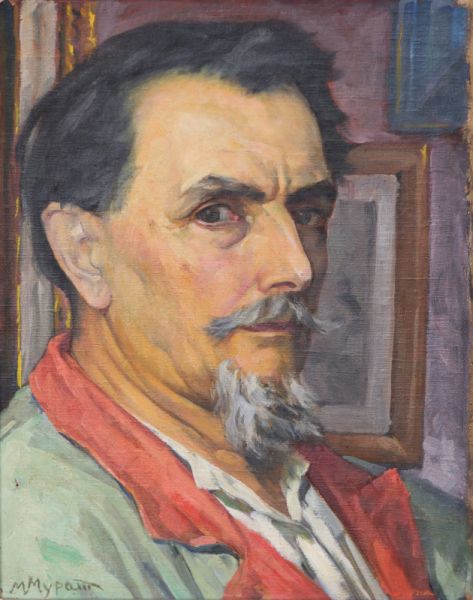
Self-Portrait (1896)
BIOGRAPHY
1862, December 30 – Marko Murat was born in Dubrava
1877 –in the autumn he entered the diocesan seminary in Dubrovnik, and attended the senior state high school.
1883-1885 – he studied theology in the theological department in Zadar. His artistic talent was noticed, and he was allowed once a week to attend the studio of the painter Franciscan Brother Josip Rossi, from whom he had his first lessons in painting.
1886 – after the drawing Meeting at Cvijeta Zuzorić’s was published in the press, in the autumn he quit theology and went to Munich to prepare to enrol in the art academy.
1887 – in October he took the entrance exam and enrolled in the academy (Akademie der Bildenden Künste) in Munich.
1893 – he completed his painting studies and returned to Dubrovnik. Urged by his friend Milenko Vesnić, who in the meantime had become Serbian minister of education, early in the following year he decided to go to Belgrade to get a scholarship to study in Paris.
1894-1898 – since he did not get the scholarship, he stayed in Belgrade and had jobs in various different schools. He lived and worked in Belgrade, Dubrovnik and Novi Sad, on the whole as a freelance artist.
1898 – he settled down to the job of high school drawing teacher in Belgrade.
1900 – Murat took part in the World Expo in Paris, at which for his monumental painting The Arrival of Emperor Dušan in Dubrovnik he won a medal and the decoration of Officier d’académie.
1901-1902 – he spent a few months in Rome, painting, and studying the monuments, thanks to Milenko Vesnić, who was there in the diplomatic service.
1904 – he was one of the founders of the federation of Slavic artists called Lada, at the exhibitions of which he was to exhibit regularly.
1904-1905 – he taught Prince Aleksandar Karađorđević, future king of Yugoslavia, drawing and art history.
1905 – together with the sculptor Đorđe Jovanović and the painters Risto and Beta Vukanović, he helped to found the Arts and Crafts School in Belgrade, at which he taught several subjects. In 1937, this school developed into the art academy.
1909 – he joined the Medulić Association of Croatian Artists, presided over by Vlaho Bukovac, in which Ivan Meštrović was a leading light.
1911 – he took part in the World Exhibition in Rome; together with Ivan Meštrović and architect Petar Bajalović, he was charged with the decoration of the Serbian pavilion.
1913 – appointed president of the committee for the organisation of artistic affairs of Serbia and South Slavism, which was supposed to work on the idea of bringing the Slavic nations closer together.
1914 – after the outbreak of World War I in July, because of his anti-Austrian stance, he was interned in then Boldogasszony Camp and then in Neusiedler (Hungary).
1916 – released in May, he went back to Šipan, where he stayed to the end of the war.
1919 – in the first part of the year he spent time in Belgrade, then returning to Dubrovnik where, at his urging, the Directorate for Art and Monuments was founded (Nadleštvo za umjetnost i spomenike); he was its first director.
1920 – in February, he became a corresponding member of the Serbian Royal Academy.
1921 – he was one of those most to be credited with a contract being signed in August between the Dubrovnik commune and the Ministry of the Army by which the many Dubrovnik monuments, above all the walls of the city, ceased to belong to the army and were handed back to the citizens of Dubrovnik.
1928-1929 – as conservator and member of the renovation committee, he was much engaged in the work on the restoration of the city bell tower.
1933 – he started to write an autobiography, entitled From My Life – Memories and Thoughts, which he never finished. The manuscript, thought for many years to be lost, was accidentally discovered and published in 2007.
1935 – he fell gravely ill and spent several months in bed, but did manage to recover long enough to paint the celebrated self-portrait today in the Dubrovnik Museum of Modern Art.
1940 – in February he became a fellow of the Serbian Royal Academy and his inaugural address was about the history of Dubrovnik painting.
1941 – a retrospective exhibition was planned for Belgrade, but was prevented by the outbreak of World War II. Some of the works he sent from Dubrovnik vanished in the turmoil of the war.
1944, October 14 – Murat died in his apartment in Dubrovnik.
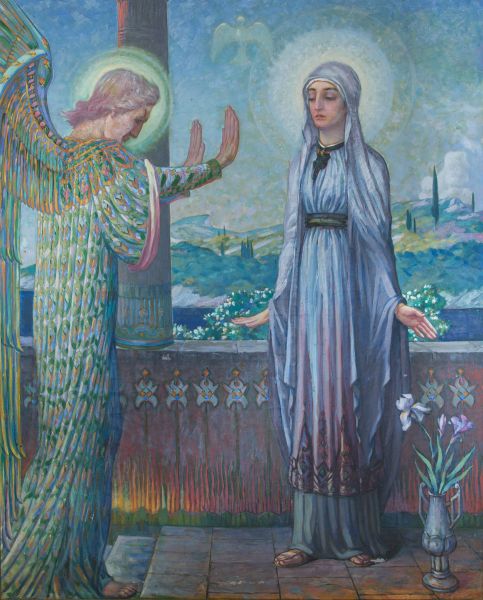
Annuncation (1920)
VIKTOR DALDON (1972) & IVANA PEGAN BAĆE (1971)
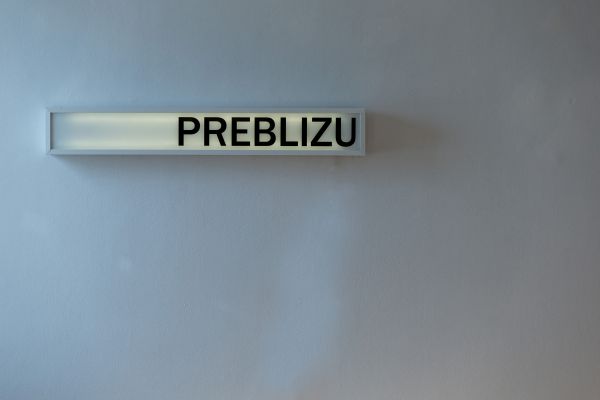
TOO CLOSE
November 8th – December 7th, 2014
Curated by: Dr. Rozana Vojvoda
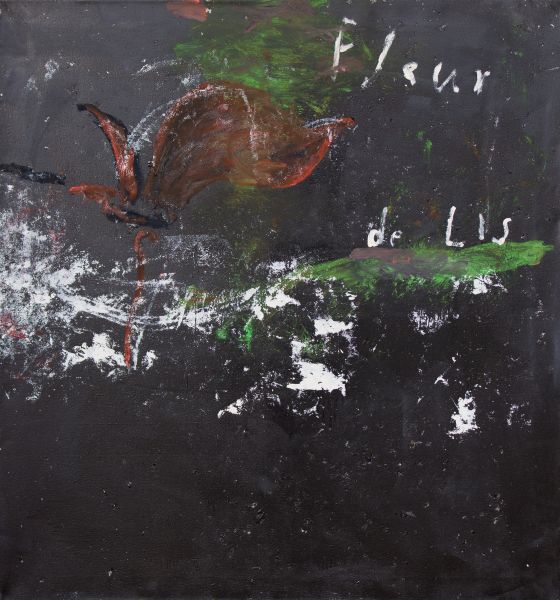
At the joint exhibition by contemporary Dubrovnik artists, painter Viktor Daldon and sculptor Ivana Pegan Baće entitled Too Close new Daldon's painting series are presented as well as the photographs, videoworks and sculptures by Ivana Pegan Baće. The artists had their first joint exhibition last year at the Flora Gallery and their dialogue continues in the Dubrovnik Museum of Modern Art in a different context and on a larger scale. It is not easy unambiguously to characterise the painting of Viktor Daldon with any of the usual concepts or adjoin it to any given line, although it does contain elements of action painting, the art of graffiti and patterns, and in some works even traces of primary and analytic painting. The works of Ivana Pegan Baće are regularly characterised by an exceptional infusion of emotion, a minimalist elegance of construction if it is sculptures that are concerned, and a purged visual language in her videos and photographs. The context of exhibiting jointly unobtrusively influenced the artists, generating two things, that in my opinion, colour this exhibition: the divergence of Daldon’s painting series and the insistence of Ivan Pegan Baće on letters and text, in some sense by way of tribute to Daldon’s frequent use of words in paintings, but primarily relating to words as the ultimate means of communication.
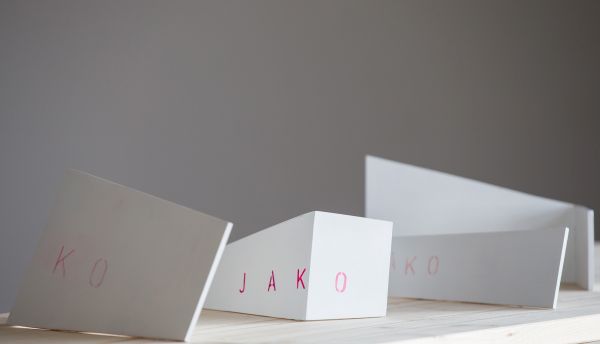
VIKTOR DALDON
Viktor Daldon was born in 1972 in Dubrovnik, where he went to secondary electrical engineering school; he enrolled in the Education Faculty in Rijeka in 1955 (fine arts section) and in 1996 went on with his studies at the Academy of Fine Arts in Zagreb. He won the university president’s prize for painting in 2001. He took his degree from the class of Eugen Kokot in 2001. He is a member of the artists’ associations HDLU and HZSU. He lives and works in Dubrovnik.
IVANA PEGAN BAĆE
Ivana Pegan Baće was born in 1971 in Doboj; took her BFA in sculpting at the Academy of Fine Arts in Zagreb in 1996. She has been a member of the two artists’ associations HZSU and HZLU since 1997. She lives and works in Dubrovnik.
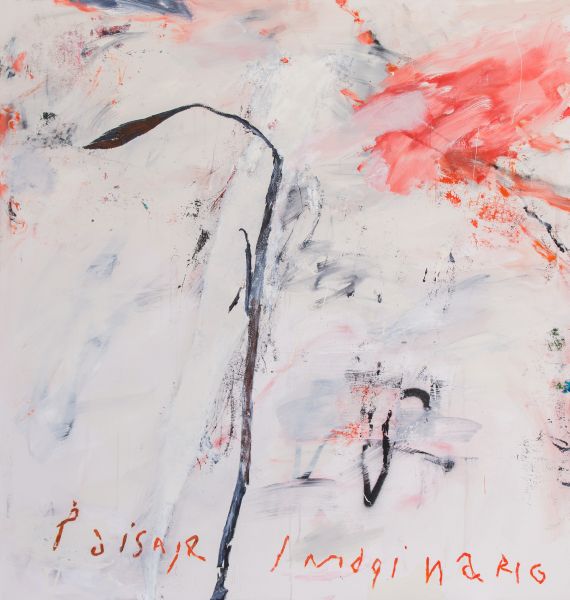
Together in the painting
Mira Šparovec i Aleksander Forenbacher
Curator: Vesna Delić Gozze
September 12th - November 2nd, 2014 Gallery Dulčić Masle Pulitika and Studio Pulitika
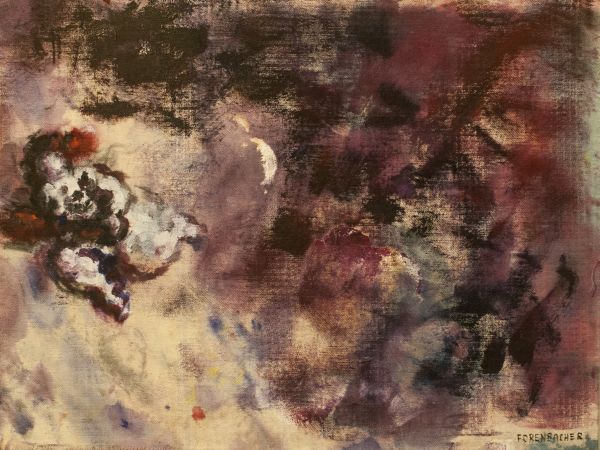
Aleksander Forenbacher, NOKTURNO, 1990. ulje na neprep. tkanini, 22 x 30 cm

Mira Šparovec, NA ŽUTOM NEBU, krajem 70-ih, ulje, 178 x100 cm
The joint exhibition of painting duo, married couple, Mira Šparpovec and Alexander Forenbacher "Together in the painting" whose first part is in the Gallery Dulčić Masle Pulitika and another part in Studio Pulitika has been opened in the Gallery Dulčić Masle Pulitika at Friday, September 12.
The exhibition will be on view until 2nd November.

Aleksander Forenbacher, CIRKUSKI JAHAČI, 2001. akril na kartonu, 69 x 46 cm

MiraSparovec-LJILJANI, početak 60-ih ulje, 38 x 33 cm
While describing the exhibition, the curator of the same, Vesna Delić Gozze about the artist Mira Šparovec in the catalogue has wrote: "Her painting works would remain unfinished, for the personal modesty of the artist did not encourage her to offer her work to the public. The paintings Circus Rider, Praying Tiger and Jarun remained in phases in which the motif was not entirely finished, but apart from that entirely rounded off, with all the indications of excellent work."
And for the other artist, Aleksander Forenbacher, Gozze wrote in catalogue: One of our very best artists in the rendering of animal figures, Alexander Forenbacher created thousands of drawings in Indian ink, achieving in rapid sketches the essence of the anatomy, stance or movement of a bird or some other animal at freedom in the wild.
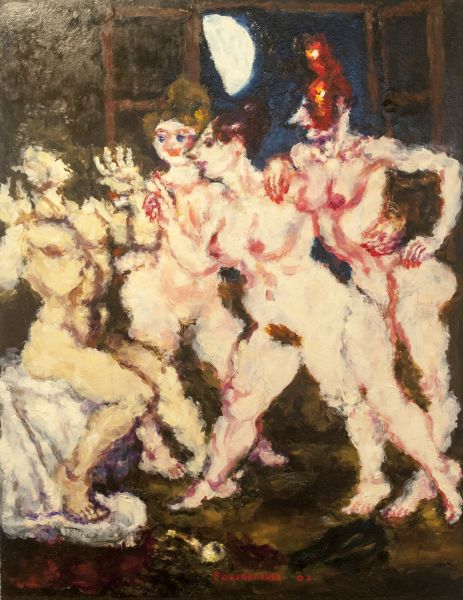
Aleksander Forenbacher, PJESNIK I HARITE, 2003. ulje na platnu, 85,5 x 66 cm
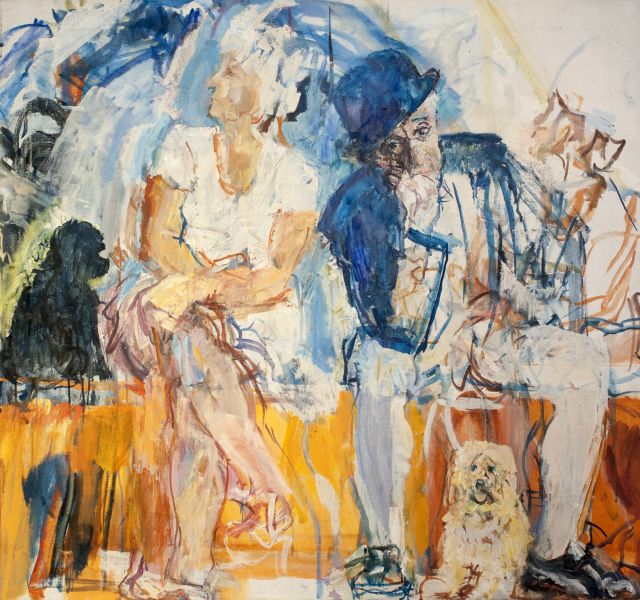
Mira Šparovec, ZVONKA I VELJKO II, nakon 1984. ulje, 89 x 97 cm
DAMIR FABIJANIĆ (1955)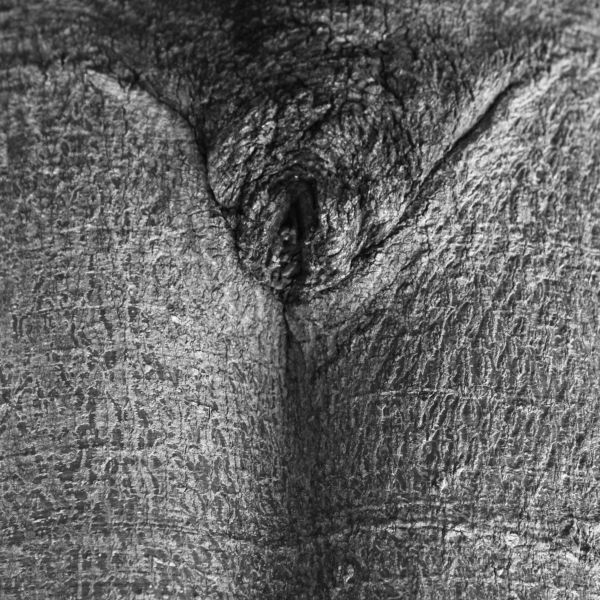
IN THE MIDST OF THINGS DBK 02
26th August - 2nd November
Curator: Vesna Delić Gozze

Portrait of person on the stump, Zagreb, 1970

The exhibition of one of the greatest Croatian freelance photographic artist Damir Fabijanić has been open in The Museum of Modern Art Dubrovnik on Thuesday, 26th August. The exhibition will be on view until 12th October.
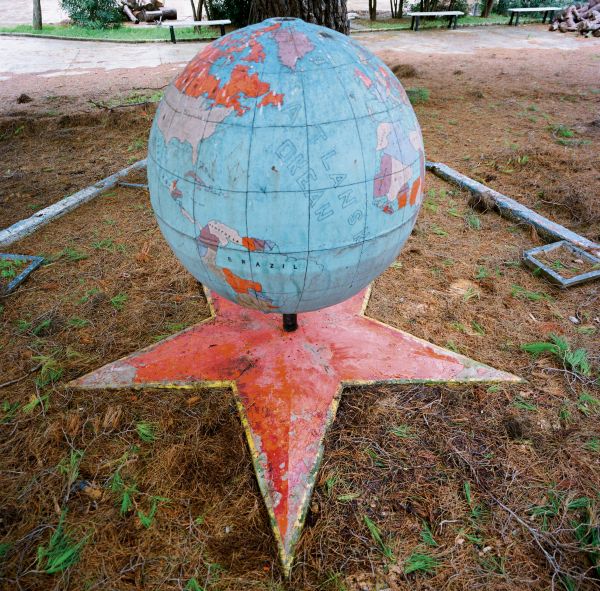 Atlantic ocean, Brijuni, 1993
Atlantic ocean, Brijuni, 1993
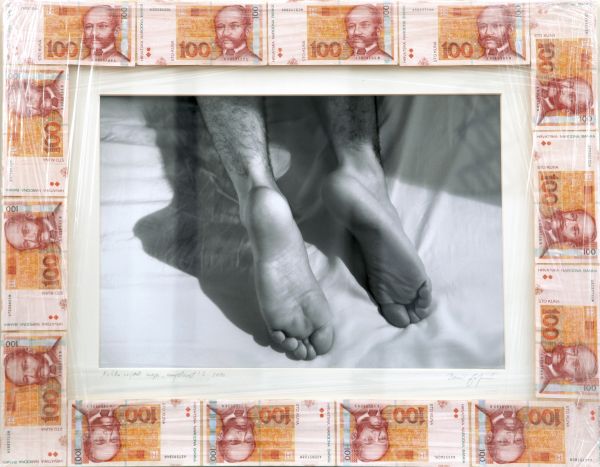
How much is my art worth?, Zagreb, 2010
While describing the exhibition, the curator Vesna Delić Gozze in the catalogue has wrote: „Information as point of departure is never the ultimate Fabijanić destination. He moves on, not exercising technicalviolence over the found situation; he attempts to record the other side of the matter, get into its pith and marrow, strip it of everything accidental, to exteriorise the invisible via sign or signal.
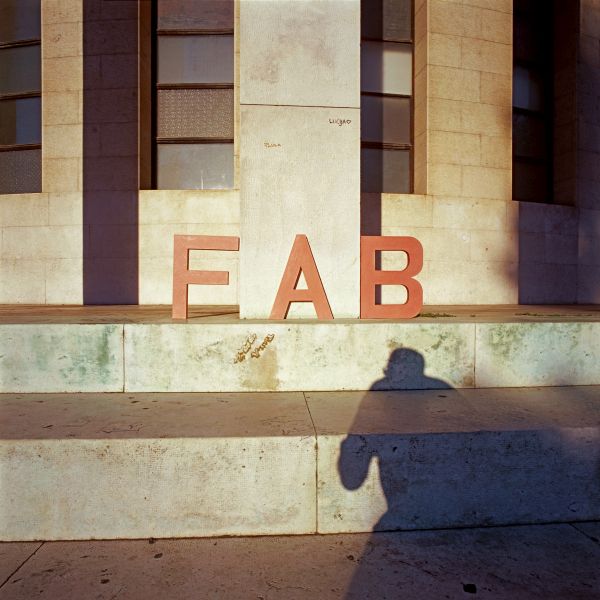
Double Fab, Zagreb, 2012
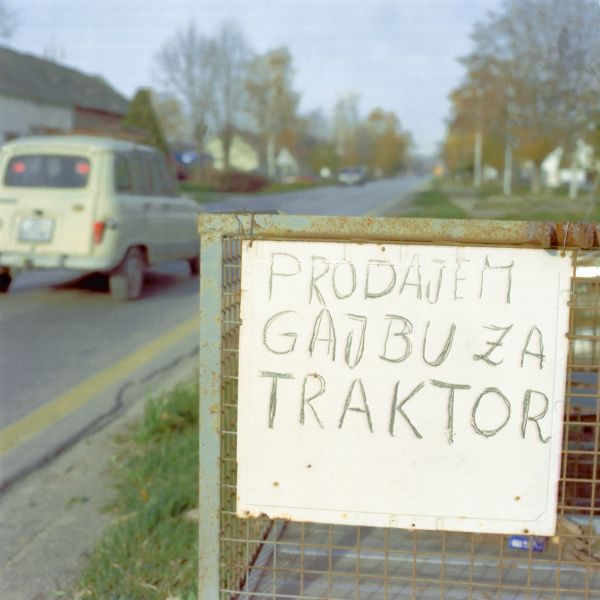
I'm selling a tractor cage, Vuka, 2000
BIOGRAPHY:
DAMIR FABIJANIĆ. Born in Zagreb in 1955. He has been a freelance photographic artist since 1987, at first specialising in architecture and landscape. During the Homeland War, he photographed the shattered cultural heritage, particularly of Dubrovnik and environs. He printed photographic material on this topic in the book Dubrovnik… An exhibition of the same name toured Europe and South America. In 1992 he took part in the most important European festival of photography, in Arles (the only Croatian photographer ever to do so). He is the chief photographer and photographic editor in the periodicals Croatia/Croatia Airlines (since 1993), Oris (1999-2008) and Iće&piće (since 2007).
MOST IMPORTANT INDIVIDUAL EXHIBITIONS
1989. Zagreb, Museum of Arts and Crafts / Sarajevo, Museum of the 14th Winter Olympics
1990. Dubrovnik, Sponza / Zagreb, Karas Gallery
1991. Piran (Slovenia), St. Donat Gallery 1992. Madrid, Centro cultural de la Villa / Arles, XXIIIe rencontres internationales de la photographie, Espace Van Gogh
1993. Neu-Ulm, Edwin Scharff Haus / Paris, Chapelle Saint-Louis de la Salpetriere 1994. Rennes, L'ecole d'architecture / Bucharest, Architecture Museum / Kishinev, Museum of Plastic Art
1995. Mainz, Rathaus / Lisbon, Câmara Municipal de Lisboa
1996. Athens, Cultural Centre of Athens
1997. Ljubljana, Small Gallery, Cankar Centre / Bratislava, Zichyho palác / Budapest, City Hall
1998. Krakov, Dom Hipolitow / Frankfurt, Palais Jalta / Zagreb, Museum of Arts and Crafts
1999.Tallin, Museum of Estonian Architecture / Buenos Aires, Centro Cultural Recoleta / Rijeka, Modern Gallery
2000. Hannover, Bauverwaltung / Lisbon, Padrão dos Descobrimentos / Brasilia, Martius Penna
2001. Porto, Casa Guerra Junqueiro / Prague, Teresian Wing of the Old Royal Palace, Hradčani
2002. Paris, UNESCO / Berlin, Auswärtiges Amt
2003. Stuttgart, Dresdner Bank / Graz, Grazer Messe
2004. Varaždin, Burg Hall / Zagreb, Culture centre of Kaptol centar
2005. Zagreb, Museum of Arts and Crafts
2007. Zagreb, Atrium of HAZU and Glyptotheque HAZU
2009. Sarajevo, Municipal Gallery Collegium artisticum, Skenderija
2010. Dubrovnik, Galerija Sebastian / Novigrad, Galerija Rigo
2012 - Zagreb, Croatian Academy Glyptotheque
2013 – Brussels/Strasbourg, European Parliament buildings
MOST IMPORTANT ARTISTIC ACHIEVEMENTS
Dubrovnik… (author of concept and photographs of exhibition and book), The exhibition was proclaimed exhibition of the week (among 59 newly-opened exhibitions) in Paris in September 1993. The book was also selected among “the most beautiful photographic books of the world” by a jury of the publisher Marval, Paris, autumn 1993.
Croatia Airlines, travel magazine, photographic editor and chief photographer since 1993.
Plodovi zla / Fruits of Evil, author of a photographic exhibition of 1995 and a book of the same name.
Paška čipka / Pag Lace, catalogue, author of concept and photography, 1995
Oris, journal for architecture, photographic editor and chief photographer,1999-2008.
Dubrovački ljetnikovac/ The Dubrovnik Villa, book, author of concept and of photographs, 2003.
London From A to Z, book and exhibition, author of concept and photography, 2004.
Počinje drugi život na našim otocima, krajem ljeta / Another life begins on our islands, at the end of summer/ book and exhibition, author of concept and photography, 2005.
Croatian Pavilion at EXPO- 2005 in Aichi and EXPO 2007 in Zaragoza, co-author of concept and production. Exhibition and book Hrvatska akademija znanosti i umjetnosti kroz fotografije / Croatian Academy of Sciences and Arts in Photographs, Zagreb, Atrium of the Academy, 2007.
Exhibition and booklet LIFE*all inclusive, Zagreb, Croatian Academy Glyptotheque, 2007.
Iće&piće, food and wine magazine, concept, main editor and chief photographer since 2007, voted by Gourmand in 2011 the third-best food magazine in the world.
- Exhibition and book In the Midst of Things, Zagreb, Croatian Academy Glyptotheque, 2012
- Exhibition Welcome Croatia (concept and selection of 38 of his own photographs), organised by the EU Parliament in honour of Croatian accession to the EU, 2012.
PRIZES (the more important)
Grand Prix of the 31st Zagreb Salon, 1996
The Vjesnik Josip Račić Prize for Fine Art, 1999, for the best art exhibition in Croatia in 1998
The Bernardo Bernardi Prize of the Association of Croatian Architects for the design and interior design of the Croatian Pavilion at EXPO 2005
COMMENDATIONS AND DECORATIONS Order of the Croatian Daystar with the figure of Marko Marulić, 1998 (not accepted) Charter as honorary citizen of the Dubrovacko-neretvanska County, 2000

Dwelling, Dubrovnik, 2010

One Eskimo during the total absence of the polar light, Zagreb, 1999
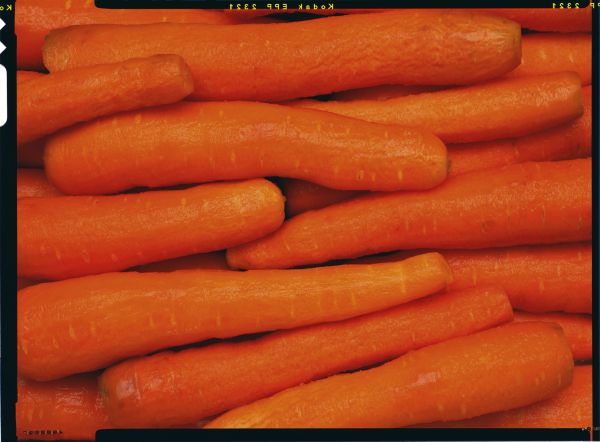 No 12, Zagreb, 1999
No 12, Zagreb, 1999
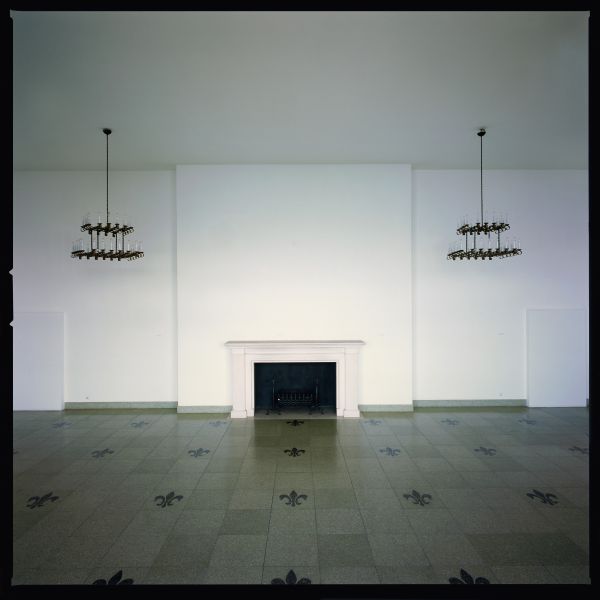
Prostor1_RUB
.jpg)
No 5, Zlatar, 2002
Galateja
Fadil Vejzović
Author of the exhibition project: Andrija Seifried
July 9th - August 10th, 2014 Gallery Dulčić Masle Pulitika and Studio Pulitika


The exhibition of an academic painter and graphic artist Fadil Vejzović will be open on Wednesday, 9th of July at 21:30 hours in Gallery Dulcic Masle Pulitika where is one part of the exhibition. The other part of the same exhibition is in the Studio Pulitika.
While describing the exhibition, the author of the exhibition project, Andrija Seifried in the catalogue has wrote: „These works draw on a figure of Galatea that is lost in space and time, which is not in the work of Fadil Vejzović bounded but is for all times, practically universal. Here we have the sure hand of the trained architect and the sensibility of the painter for whom art is an endless divine freedom to create.”
BIOGRAPHY:
Fadil Vejzović was born in Sarajevo 1943. From 1962-1965 he studied at the Academy of Fine Arts in Zagreb. Since 1969 he has worked independently but also as a member of the Brezovica group. From 1970-1975 he was attending post-graduate course in printmaking and painting at the Akademie der bildende Kunste in Nuremberg. From 1976-1986 he has worked in the magazine Start as illustrator and graphic editor. He has been awarded a number of prizes and grants and he exhibits in Croatia and all around the world. Since 2007 Vejzović has been represented in the permanent display of the Modern Gallery in Zagreb. He lives and works in Zagreb.
JOŽE CIUHA (1924)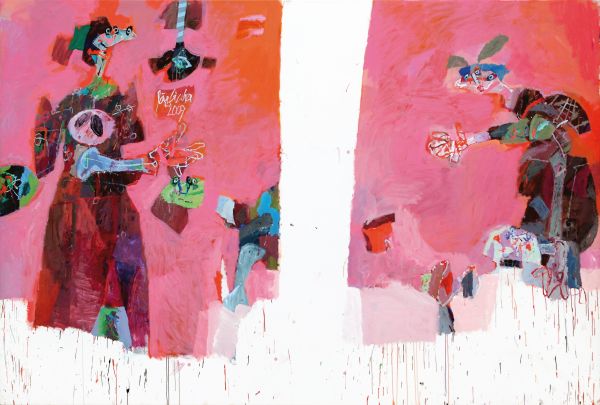
Fire Before Night
ISLAND IN THE SOUL
3rd July – 10th August 2014
Curated by: Vesna Delić Gozze
While describing this exhibition, it´s curator, Vesna Delić Gozze has wrote: „It covers the creative period from the early sixties and includes the heterogeneous materials of the author that with oxymoronic skill have connected the danse macabre with the winsome, seductive call of the fragile play of life. “
Academic Tonko Maroević in the catalog has described his work this way: „...from virtuoso sketches in drawing, via brilliant rhythmical surfaces on plexiglass, or dynamically articulated acrylics on canvas and sophisticated chromatic applications of watercolour on paper, the ranges of technique and execution are significant, reconciled and evened out as they are with the lively temperament of the author’s personal style and his cunning compositional approaches, appropriate to every one of the media chosen.“
“His artistic expression contains experiences of the forms and colours of the Near and Far East, of Asia and America, and of course, of Europe, in a range from the early and late Renaissance, to the Spanish Golden Age and - perhaps most strongly – the austere rituals of Byzantium, without any of these elements being felt as a foreign body or considered as restrictive and incompatible”, Zoran Kržišnik has wrote.
BIOGRAPHY
Jože Ciuha was born in 1924 in Trbovlje. He studied at the Academy of Fine Arts in Ljubljana. He presented his works at over 500 one-man and 400 group exhibitions.
He received several awards, among others the Prešern Fund Award, the Jakopič Award, the French title of the Chevalier of Fine Arts and Literature, the Austrian Honorary Cross of Sciences and Arts and of the Rank. He is a member of the Russian Academy of Arts.
He dedicates himself to painting, graphic arts, mosaic and literature.
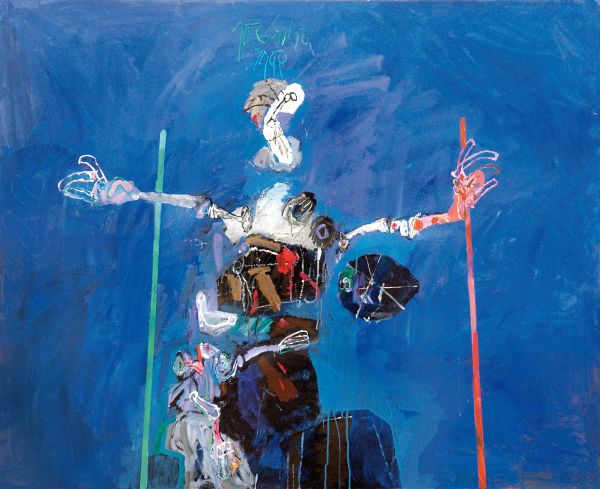
Nor Left nor Right
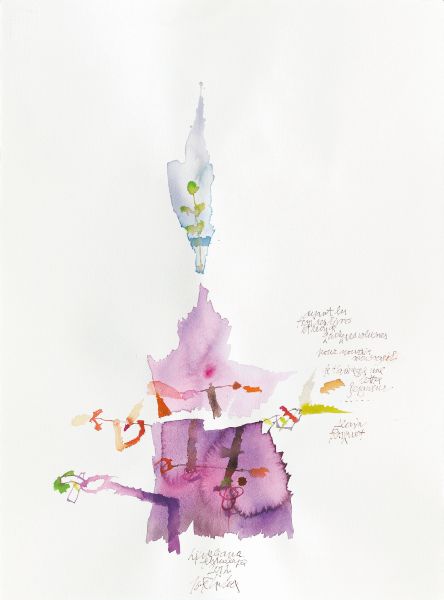
Alain Bosquet, Ausandt du tron des livres et redige quelques volumes pour nourair monorgeril je t´adresse une lettre seigneuer 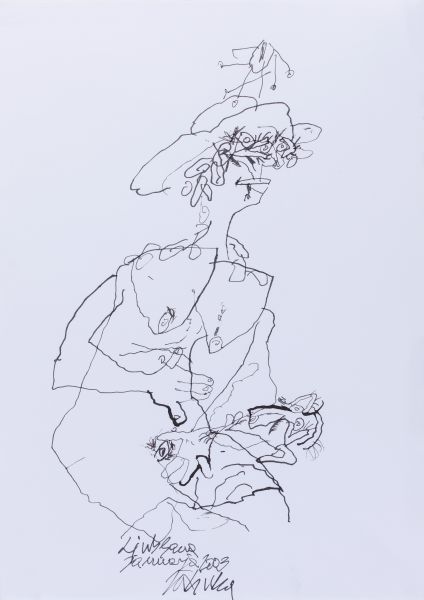
Woman and cat
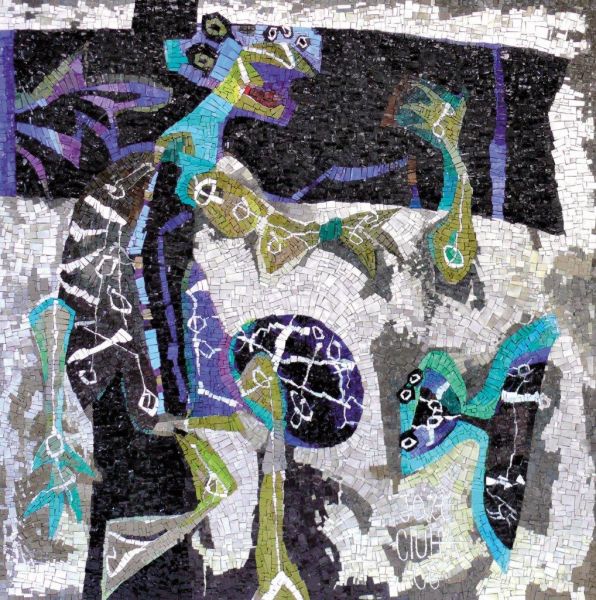
Orpheus and Eurydice
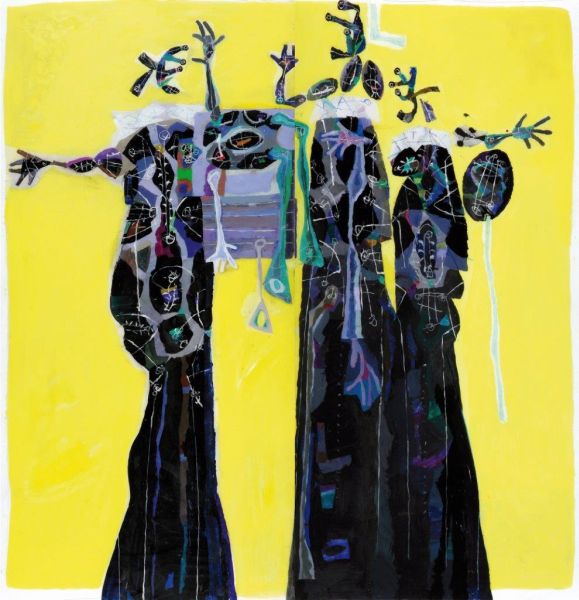
Yellow Pieta
BORIS BUĆAN (1947)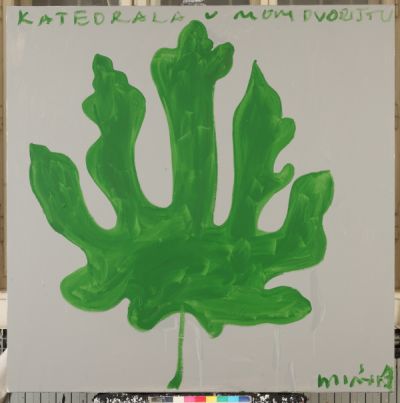
Cathedral in my Backyard
SCENES FROM CONTEMPORARY LIFE
May 15th - June 29th, 2014
Curated by: Vesna Delić Gozze
This selection of recent pieces by Boris Bućan shows a considerable part of the capacious production of works in painting by this ingenious Croatian artist who, after a period of superlative prints, has devoted himself almost exclusively to painting with acrylics on canvas.
Boris Bućan is an artist whose work makes him eternally young, from his constantly new fascination with metaphor, into which in his painting laboratory he turns the whole of the outside world, attentively following and conveying it in impossible combinations. This painting is iconographically close to the figure of speech of the simile, in which the conjunction “like” has simply been lost. So the whole of his work in painting pulsates with transformations of one thing into another, created by the merging of things that are in fact physically distant from each other.
BIOGRAPHY
Boris Bućan was born in Zagreb at 1947. He graduated from the Academy of Fine Arts in Zagreb in 1972. His artistic practice includes drawing, graphics and graphic design. He pays special attention to the issue of the anonymous media message which he personalizes through humorous interventions in the template (Bućan Art, 1971). At the start of his career, he created posters for the Student Center in Zagreb (Gallery and the ETC. Theatre) and Drama Theatre Gavella (1967-1972). Between 1980 and 1982 he created a famous large-sized poster series recognized for their picturesque quality for Croatian National Theatren in Split, and for the concert program of Radio-Television Zagreb. After the series was exhibited at the 1984 Venice Biennial, Bućan earned international fame.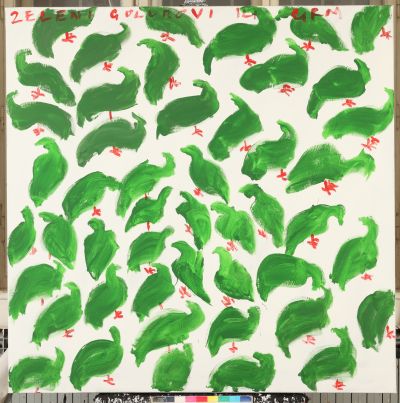
Green Pigeons or Shrub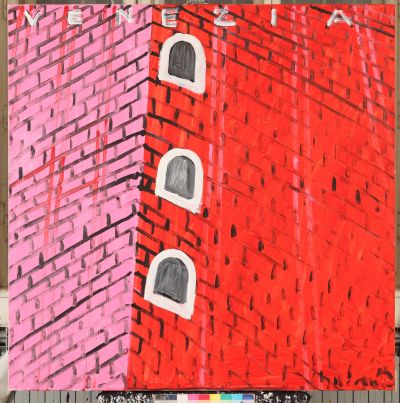
Venice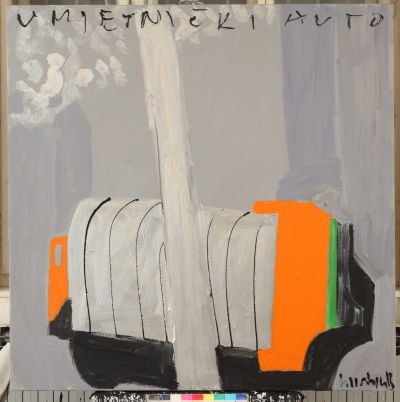
Artistic Car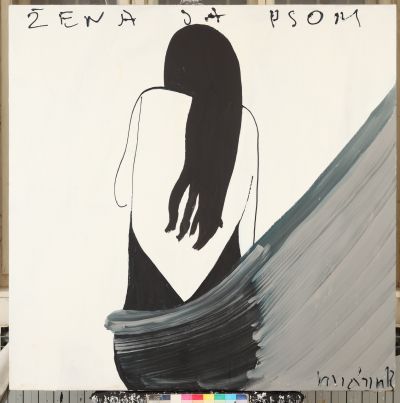
Woman with a dog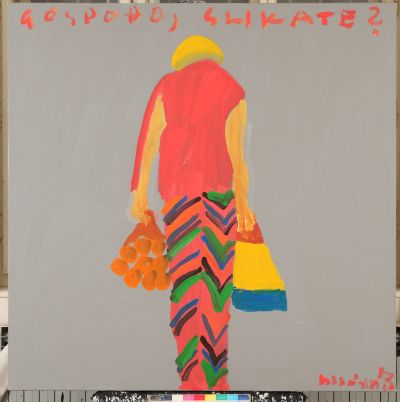
Ma´am, Do You Paint?
My life, my way
Mercedes Bratoš
Curated by: Vesna Delić Gozze
May 6th – July 6th, 2014 Gallery Dulčić Masle Pulitika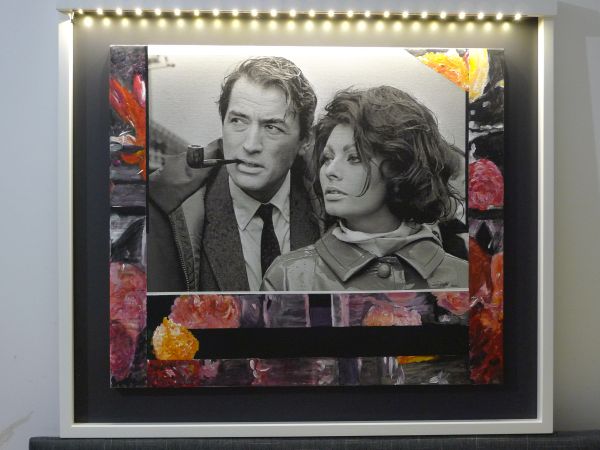
"The geometrism of Mercedes Bratoš always bears the trace of something lyrical, a breath of still life present in the motif, or some winged or animal imprints. Compositional austerity along the lines of Lissitzky’s Constructivism is here toned down by the outlines of identifiable determinants of the exterior world of things and in the vertical treatment of abstract figures in the weightless space of compositions in free flight. From the initial exactly determined precision of geometrical figures and an analysis of them the painter creates hovering objects imperfect in their symmetry but always harmonised in the levitation of life and some kind of choreography of their own." - Vesna Delić Gozze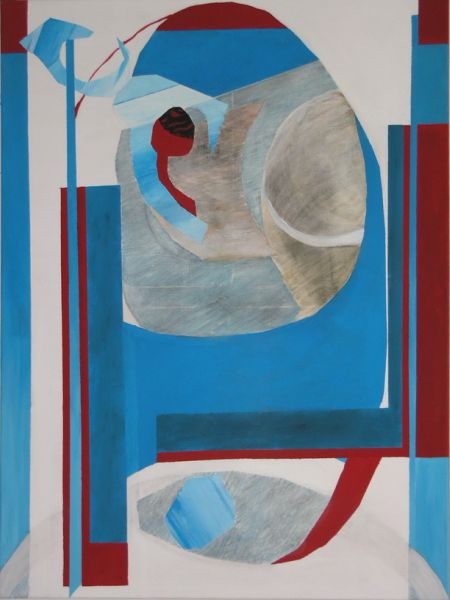
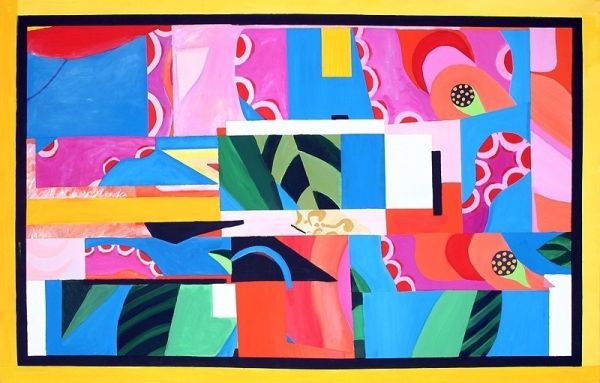
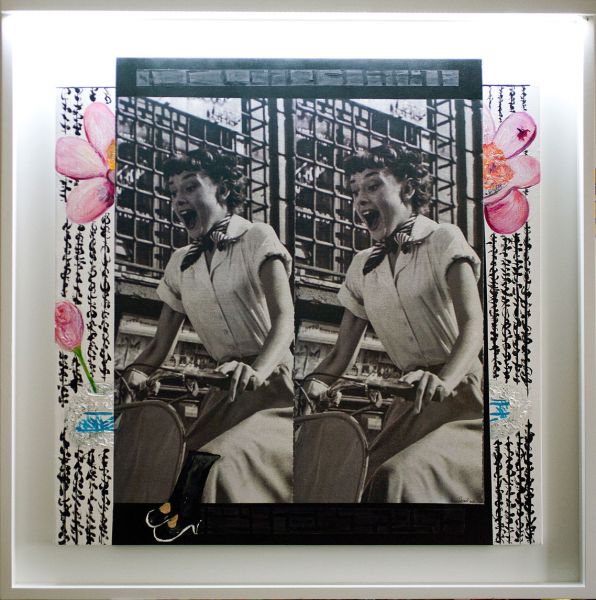
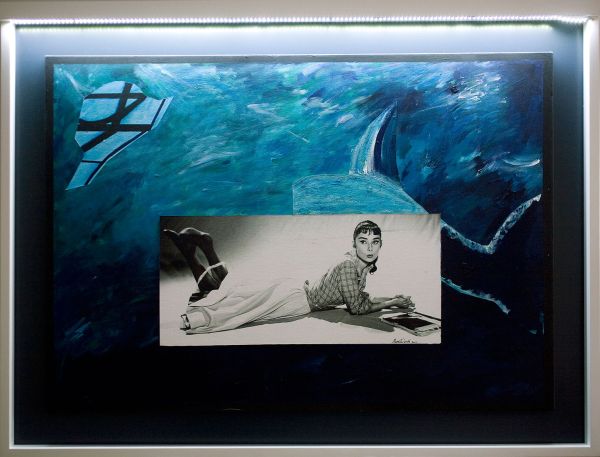
DAMIR STOJNIĆ (1972)

ILLUMINATIONS
April 15 th – May 11 th, 2014
Curated by: Dr. Rozana Vojvoda
At this presentation of Rijeka painter and performance artist Damir Stojnić in Dubrovnik, the most copious ever there are three series of works: Anarchitecture-Terrarium (1993-1999), Transparencies (1997-2013) and Ignisograms (2004.-2009.). In Anarchitecture-Terrarium, in a sense emblematic of the artist, Stojnić shows animals in flocks and herds, creating in his reduced visual language (monochromes, with perspectival foreshortenings) works of an elemental power, which invoke cave drawings in our minds and bring us up short against a very direct and precise analogy with human nature.
In watercolours and canvases from the Transparencies series, he uses the visual method of the multiplication and merging of contours that dematerialise figures and objects in various phantasmagoric compositions, in which there are winged people, mythological animals and hybrid beings similar to the marginalia of medieval manuscripts, in brief an imaginary of symbolic charge taken over from differing spheres.
In the series of documented performances called Ignisograms (2004-2009) he creates “fire drawings”, which are created in two Istrian quarries, in the artist’s words “fire studios 1 and 2”, in which the artist places branches in stone-defined fireplaces in the form of man, butterfly, heart and so on, lights a fire and then blows them up with the blowpipe that is used in Istria instead of the bellows and obtains depictions/drawings from the embers. The whole process is documented with video and photos, and the ultimate product, a smouldering image of a red and orange granular structure, with a moving and animated form, is akin to Stojnić’s paintings both in the magian and ritual and in the visual component.
The series of Damir Stojnić selected tell of the author’s versatility, his very uncommon creativity, and most of all the inner necessity according to which for years his creative journey has unfolded.

.jpg)
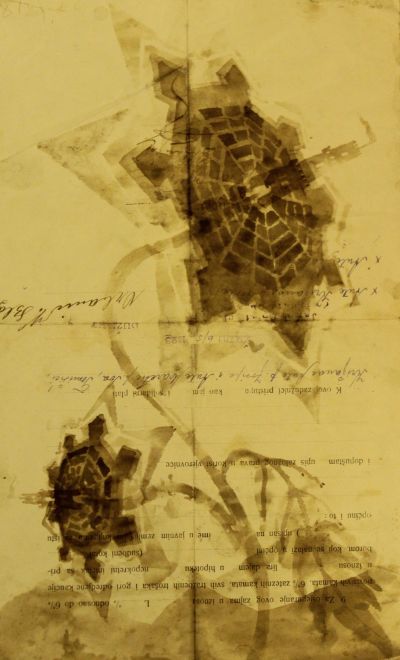

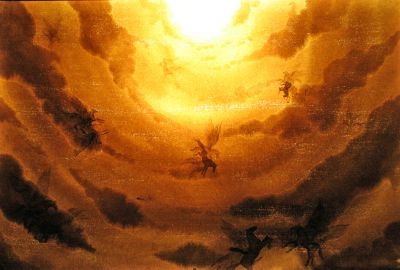
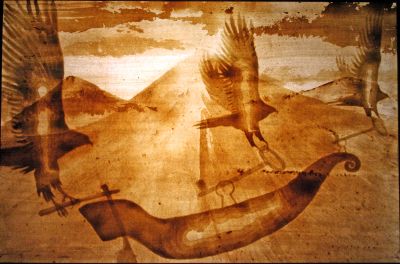
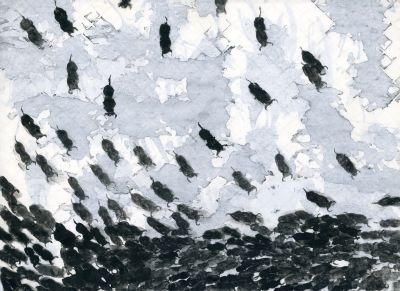
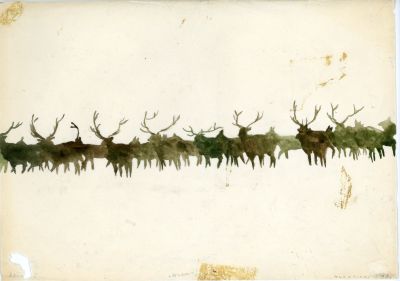
KATARINA IVANIŠIN KARDUM (1975)
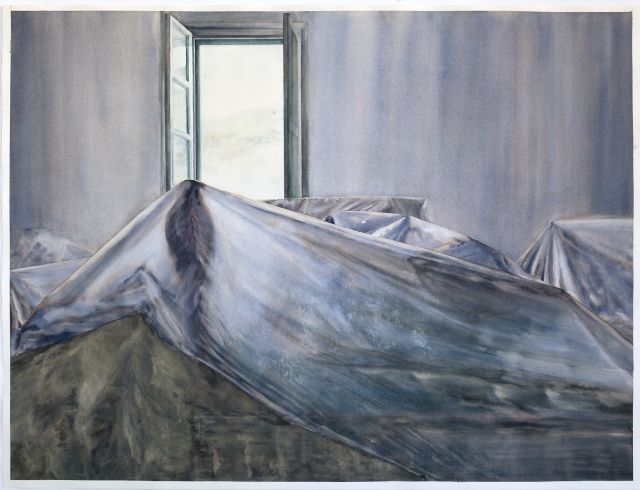
still landscape series-bez naziva_2014_akvarel
Still Landscapes
Exhibition layout: Katarina Ivanišin Kardum, Petra Golušić
Curator: Petra Golušić
Text: Petra Golušić, John Stezaker
April 10th, 2014 – May 11th, 2014
The exhibition features painting, monotypes, watercolours, drawings and collages from four series: the graphite and resin (2000-2006), the cityscape 1 (2003-2004), the still landscape (2011 onwards) and the city out of my window (2005 onwards) series.
The first series is represented by the wall composition graphite and resin series, a fifteen-part composition done on paper in the technique of graphite dust and industrial resin. Seven collages with a motif of the historical centre of Dubrovnik belong to the cityscape series 1, while scenes of dioramas from Dubrovnik Natural History Museum are rendered in drawings and watercolours from the still landscape series. The facade of a Zagreb factory is offered to the eye of the view in watercolours and drawings of the city out of my window. The watercolour polyptych entitled the city out of my window: vesna, a four-part composition is the first part of the series the city out of my window, the sketches for which can also been seen at the show.
Like signs, the works in these units have an identical qualitative degree of presence and value that is comprehended from several semantic views within them. They are revealed to the viewer above all as separate codes that are gently and yet powerfully inscribed into the surface of the paper, representing way stations of the course of thinking led by an internal link unburdened by the superfluous./…/ Her work transfigures within itself the meanings, point, value, systems of the perceptive conditions of the space with which she is concerned. She creates an imaginary landscape that she immerses in the direction of abstraction; she brings the observer into the process of the dissolution and simplification of situations as found, in which the motif of the urban landscape is dominant; she tests out in certain traces of a cultural, value-related, ideological and receptive and so on situation, always being as she does so sensual and unobtrusive./…/ The employment of analysis and exploration about the nature of art in specific and traditional media is immanent to
the work of Katarina Ivanišin Kardum, in which there are culture-studies and semiotic debates present, relating to the aesthetic and ethical consideration of inter-subjective and spiritual relations.
Catalogue written by the exhibition curator, Petra Golušić.
The English theorist and conceptual artist John Stezaker (1949) says in the same catalogue of the exhibition: Katarina Ivanišin’s works remind me of what Rilke in his first ˝Duino Elegy˝ said about beauty being the beginning of a terror too much to bear. Her work seems sometimes too beautiful to endure. There is a quality of sheerness, of a terrifying transparency which is at once deeply seductive and frighteningly alien. Her images often seem like ecstatic dematerialisations of the world, evoking an almost oriental sense of the void beyond the phenomenal world as in her early ˝graphite and resin series˝ where the visible seems to melt into a veil like transparency./…/ The main series of works which make up her oeuvre to date hinge on a metaphysical ambiguity between the presence and absence of the world and all have the threshold space of the window as their focus. The different series explore the ambiguities of representation, centring on the subject of the window and seem compelled by the desire to make the impossible bridge between looking at and looking through the window./…/
BIOGRAPHY
Katarina Ivanišin Kardum was born in 1975 in Dubrovnik, and in 1993 graduated from the city’s Science and Mathematics High School. She attended a one-year foundation course at the City and Guilds of London Art School from 1994 to 1995, and went on studying fine art painting at the same school until she took her degree there in 1998. She concluded a two-year post-graduate course in painting at the Royal College of Art in London in 2000. She went on with her career in London until she moved to Croatia in 2004. Working as a freelance artist, she was a full-time lecturer at the undergraduate course of the City of Guilds of London Art School, continuing to be a guest lecturer even after she moved to Croatia. During 2000, she was a guest lecturer at the Ruskin School of Art at Oxford University.
In 2007 she organised and coordinated the exhibition Nature and Society
– Parallel Lines (Dubrovnik Museums, Ethnographic Museum) at which contemporary
Croatian and British artists exhibited.
Since 2009 she has been employed as museum educator at the Dubrovnik Natural History Museum, in which she has authored or co-authored several museum educational programmes, publications, the museum catalogue and two didactic exhibitions.
She has been awarded a number of prizes and grants and her works have been placed in the collections in the United Kingdom, Croatia and Hong Kong. Her works were used in the film of Simon West Lara Croft: Tomb Raider (2001).
She has had solo shows in Dubrovnik, London and Brussels, and taken part in a number of international and local exhibitions.
She lives and works in Dubrovnik, Zagreb and Drače.
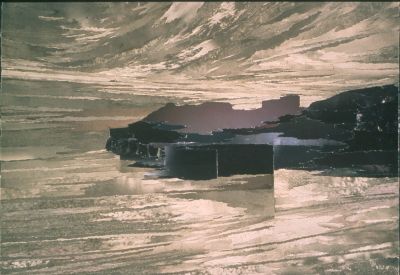
cityscape series 1 _ _5_2004_kolaz
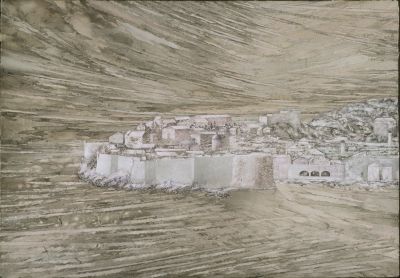
cityscape series 1 __8_ 2004_ kolaz
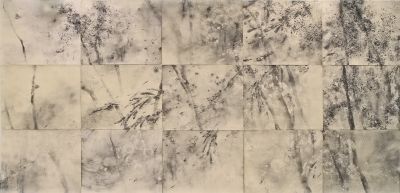
graphite and resin series _2004–2006_grafitni prah i industrijska smola na papiru
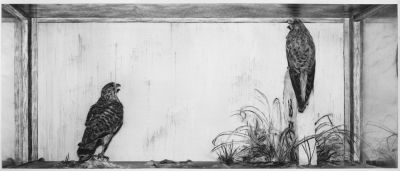
still landscape series - a couple-Falco Tinnunculus_2014 _ugljen na papiru
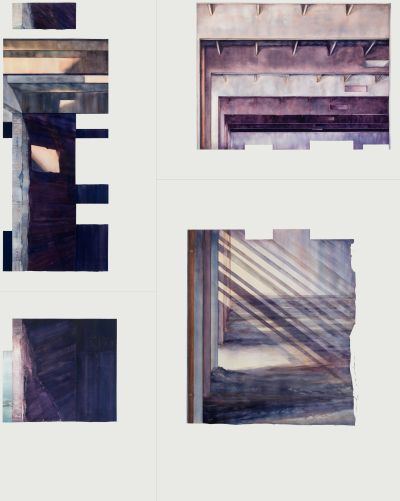
the city out my window _cetvreodijelna kompozicija_2013 -2014_ akvarel
IZVOR PENDE (1976)
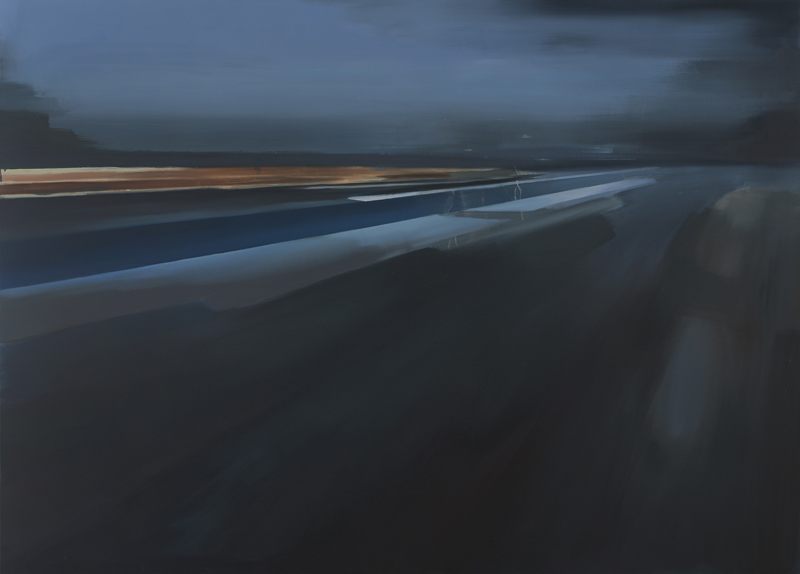
Metamorphoses III
Exhibition layout: Izvor Pende, Nancy von Breska-Ficović
Curators: Nancy von Breska-Ficović, Vesna Delić Gozze
Text: Vesna Delić Gozze, Nancy von Breska-Ficović, Michael Stoeber, Daniel Richter
February 20th, 2014 - March 30th, 2014
In the exhibiton Metamorphoses III, by the painter Izvor Pende, the artist´s latest work will be shown.
There are four authors of the catalogue text. Vesna Delić Gozze, describing the motifs of his artworks said: „In Pende, it is not enrapturement by the scene that rules; rather, a restrained monitoring of the powerful duality of sea and sky. With the woman between. Pende's painterly outcome is in some sense close to the implacably denuding effect of motif from the paintings of Edward Hopper and his clearly defining cold light."
Micahael Stoeber thinks that the painter's persistent dedication to sea and woman might perhaps recall to some observer a theatrical performance entitled Waves of sea and love (work by Austrian playwright Franz Grillparzer) . He also thinks that in the work of Pende, love is present in metonymy, so he said: „Woman as allegory of love does not appear in Pende in the indicative, but in the subjunctive. Not as reality, but as possibility."
Except on the motifs of a women and the sea, Daniel Richter talks also about the motif of Dubrovnik: „In these paintings, Dubrovnik is still a backdrop for dreams, a place for fantasies beyond the human masses and the tourist frippery. A melancholy wind blows through the painting, as if through the city, when the day has still not started, and the night is not yet over."
„Although the earlier phases in Izvor Pende's work are thematically and stylistically to be distinguished from the new, it can be said that this step in the evolution of his painting style is a kind of summa of all his previous experiences and researches. Through a cancellation of the presence of the female figure and the gradual distinction of the borders of the space the artist has gradually liberated himself from the dominant motifs in the composition. ", said Nancy von Breska – Ficović.
Biography:
Izvor Pende was born in Zagreb in 1976. After two years at the Art academy Zagreb, in 1998 he goes on Painting studies at Kunstakademie Düsseldorf, where he graduated in 2005. He had exhibited since 2003 in solo exhibitions at home and abroad. He had exhibitions in Bonn, München, Hannover, Düsseldorf, Zagreb, and in Dubrovnik four years ago.
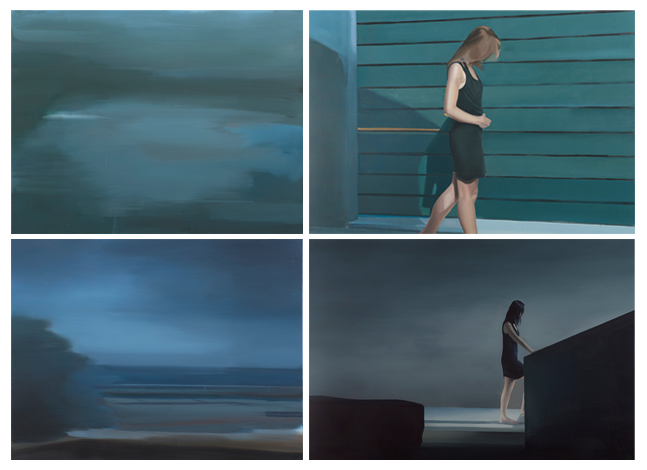
«BUKOVAC SISTERS»
JELICA BUKOVAC RADOSAVLJEVIĆ (1897 - 1967)
IVANKA BUKOVAC JAVORSKY (1899 - 1978)
Curated by: Dr Rozana Vojvoda
February 6th – March 16th, 2014
The exhibition presents works by Jelica Bukovac Radosavljević and Ivanka Bukovac Javorsky preserved in the Museum of Modern Art Dubrovnik, The Bukovac House in Cavtat and private collections in Dubrovnik, Cavtat and Zagreb. The fact that Ivanka and Jelica were the daughters of the celebrated Vlaho Bukovac, key figure in the development of Croatian modern painting, was a double-edged sword for both of these (women) painters. On the one hand, it was to him they owed their systematic teaching in art from their youth. On the other they were unable until the end of their lives to break free of their father's heritage, and remained more or less bound to academic realism and en plein air painting, totally ignoring the avant-garde movements in the art of the twentieth century.
Art historians have never systematically concerned themselves with the work of the "Bukovac sisters", however much it is clearly the product of talented painters, even, indeed, of the first women students at the Prague Academy of Fine Arts. This is mostly because of the weight of the surname of Bukovac and the comparisons that would have been insisted upon, and that of course would have been to the detriment of the women painters.
This exhibition is endeavouring to take a step towards a revaluation of the oeuvre of the Bukovac sisters, for however much it might be inferior to their father's, their interesting work should certainly not be left at the level of the curiosity.
Ivanka Bukovac Javorsky was born in 1899 in Cavtat. She had received private lessons from her father, Vlaho Bukovac and studied at the Academy of Fine Arts in Prague from 1921 – 1928. In 1945 she became member of „The association of Czechoslowak artists" in Prague She moved from Prague to Cavtat in 1968 where she died in 1978.
Jelica Bukovac Radosavljević was born in 1897 in Zagreb. She had received private lessons from her father, Vlaho Bukovac and studied at the Academy of Fine Arts in Prague from 1921 – 1924. She interrupted the studies to resume them in 1938-1939. She died in 1967 in Cavtat.
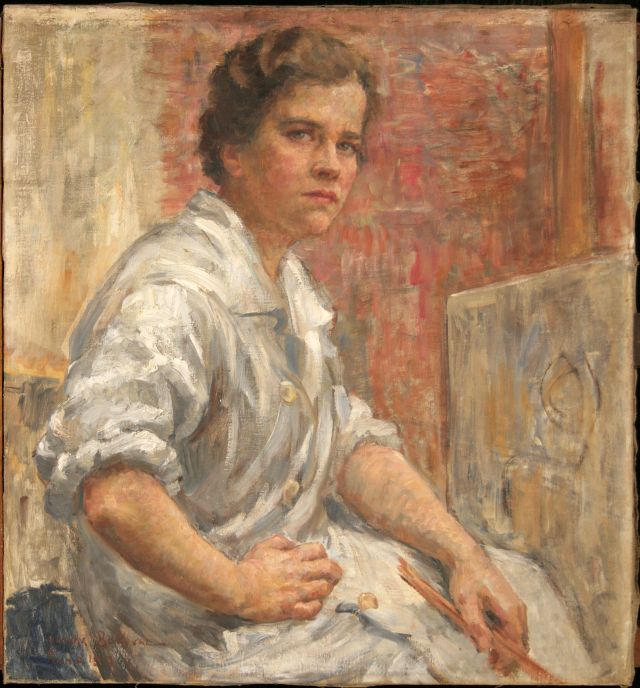
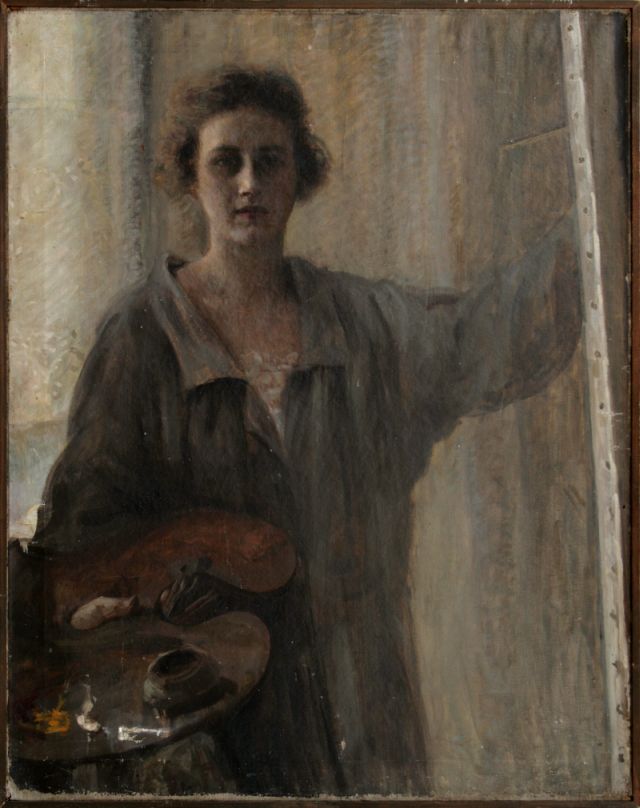
LEON ZAKRAJŠEK
Susret kistom
kustosica: mr.sc. Vesna Delić Gozze
mjesto izlaganja: Galerija Dulčić Masle Pulitika, Atelijer Pulitika
21. prosinca 2013. – 26. siječnja 2014.
Izložba «Susret kistom» poznatog slovenskog umjetnika predstavlja 35 radova (monotipije izložene u Galeriji Dulčić Masle Pulitika i akrilici izloženi u Atelijeru Pulitika), koji su nastali u posljednje tri godine i inspirirani su nasljeđem tradicionalne japanske umjetnosti.
....."Okupiranost Zakrajšekove pozornosti dijelom japanskoga tradicionalnog izražavanja može se ogledati kao interpretacija Zapadnjaka koji je dostatno, a kako priliči polju umjetnosti i nikad potpuno, ušao u zabranu vrijednosnog poimanja jednoga, japanskog Drugoga. Teoretiziranje o Drugome može biti i kliše kojim se, iako blagonaklono, priznaje pravo na drugi način, ali u praksi to razumijevanje je češće obilježeno nedostatkom potrebe za približavanjem onom različitom i drukčijemu čija bi blizina mogla poremetiti vlastiti, prihvaćeni "red stvari". Zato je ovoj analizi bliskija teza da je, primijenjena na kreativni rad, boravak u drugoj sredini ponajprije prilika za prepoznavanje sebe u drugome ma koliko taj bio egzotičan kao i mogućnost harmonične korespondencije s vlastitim promišljanjima i osjećajima nastalim iz neprocjenjive šanse u sudaru s nepoznatim. Prilagođavajući se, mijenjamo sebe. Potom i sredinu koja nas je promijenila." ..... (mr.sc. Vesna Delić Gozze, iz teksta kataloga izložbe)
Biografija:
Leon Zakrajšek, rođen 1962. godine, djeluje u području apstraktnoga slikarstva i umjetničke grafike kao autor i promotor originalnoga grafičkog jezika. Studirao je na Akademiji za likovnu umjetnost Sveučilišta u Ljubljani. Likovno se razvijao na međunarodnim likovnim učilištima kao što su španjolski Centre Internacional de Recerca Gràfica, japanski Tama Art University kao stipendist japanske vlade, kao i u ateljeima za grafiku Hanga Kobo-Seya-ku gdje ga prati mentor Harumi Sonoyama i kod majstora drvoreza kao što su Fumio Kitaoka, Yuki Rei te Seiko Kawachi. Od godine 1987. član je Udruženja slovenskih likovnih umjetnika; od ljeta 1998. godine član je Kamakura Print Collection, a godine 1996. u Italiji je dobio naziv Cavaliere dell'Arte – Vitez umjetnosti. Samostalno izlaže od 1977. godine, od kada je izlagao na više od 120 samostalnih izložbi u Austriji, Kini, Francuskoj, Hrvatskoj, Italiji, Izraelu, Japanu, Sloveniji i Srbiji. Sudjelovao je na više od 230 grupnih izložbi na svim svjetskim kontinentima. Njegovi radovi su uključeni u mnoge privatne i institucionalne umjetničke zbirke diljem svijeta, a mnogi su od njih nagrađeni vrijednim nacionalnim i međunarodnim priznanjima Italije, Francuske, Malte i Japana. Živi i radi u Zagrebu.






